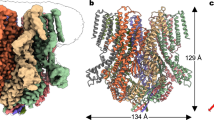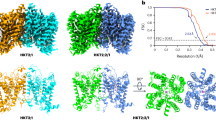Abstract
Plants counteract fluctuations in water supply by regulating all aquaporins in the cell plasma membrane. Channel closure results either from the dephosphorylation of two conserved serine residues under conditions of drought stress, or from the protonation of a conserved histidine residue following a drop in cytoplasmic pH due to anoxia during flooding. Here we report the X-ray structure of the spinach plasma membrane aquaporin SoPIP2;1 in its closed conformation at 2.1 Å resolution and in its open conformation at 3.9 Å resolution, and molecular dynamics simulations of the initial events governing gating. In the closed conformation loop D caps the channel from the cytoplasm and thereby occludes the pore. In the open conformation loop D is displaced up to 16 Å and this movement opens a hydrophobic gate blocking the channel entrance from the cytoplasm. These results reveal a molecular gating mechanism which appears conserved throughout all plant plasma membrane aquaporins.
This is a preview of subscription content, access via your institution
Access options
Subscribe to this journal
Receive 51 print issues and online access
$199.00 per year
only $3.90 per issue
Buy this article
- Purchase on Springer Link
- Instant access to full article PDF
Prices may be subject to local taxes which are calculated during checkout






Similar content being viewed by others
References
Preston, G. M., Carroll, T. P., Guggino, W. B. & Agre, P. Appearance of water channels in Xenopus oocytes expressing red cell CHIP28 protein. Science 256, 385–387 (1992)
Johansson, I., Karlsson, M., Johanson, U., Larsson, C. & Kjellbom, P. The role of aquaporins in cellular and whole plant water balance. Biochim. Biophys. Acta 1465, 324–342 (2000)
Agre, P. & Kozono, D. Aquaporin water channels: molecular mechanisms for human diseases. FEBS Lett. 555, 72–78 (2003)
King, L. S., Kozono, D. & Agre, P. From structure to disease: the evolving tale of aquaporin biology. Nature Rev. Mol. Cell Biol. 5, 687–698 (2004)
Tamas, M. J. et al. A short regulatory domain restricts glycerol transport through yeast Fps1p. J. Biol. Chem. 278, 6337–6345 (2003)
Johanson, U. et al. The complete set of genes encoding major intrinsic proteins in Arabidopsis provides a framework for a new nomenclature for major intrinsic proteins in plants. Plant Physiol. 126, 1358–1369 (2001)
Morishita, Y., Sakube, Y., Sasaki, S. & Ishibashi, K. Molecular mechanisms and drug development in aquaporin water channel diseases: aquaporin superfamily (superaquaporins): expansion of aquaporins restricted to multicellular organisms. J. Pharmacol. Sci. 96, 276–279 (2004)
Borstlap, A. C. Early diversification of plant aquaporins. Trends Plant Sci. 7, 529–530 (2002)
Johansson, I. et al. Water transport activity of the plasma membrane aquaporin PM28A is regulated by phosphorylation. Plant Cell 10, 451–459 (1998)
Johansson, I., Larsson, C., Ek, B. & Kjellbom, P. The major integral proteins of spinach leaf plasma membranes are putative aquaporins and are phosphorylated in response to Ca2+ and apoplastic water potential. Plant Cell 8, 1181–1191 (1996)
Tournaire-Roux, C. et al. Cytosolic pH regulates root water transport during anoxic stress through gating of aquaporins. Nature 425, 393–397 (2003)
Murata, K. et al. Structural determinants of water permeation through aquaporin-1. Nature 407, 599–605 (2000)
Sui, H., Han, B. G., Lee, J. K., Walian, P. & Jap, B. K. Structural basis of water-specific transport through the AQP1 water channel. Nature 414, 872–878 (2001)
Savage, D. F., Egea, P. F., Robles-Colmenares, Y., O'Connell, J. D. & Stroud, R. M. Architecture and selectivity in aquaporins: 2.5 Å X-ray structure of aquaporin Z. PLoS Biol. 1, E72 (2003)
Gonen, T., Sliz, P., Kistler, J., Cheng, Y. & Walz, T. Aquaporin-0 membrane junctions reveal the structure of a closed water pore. Nature 429, 193–197 (2004)
Harries, W. E., Akhavan, D., Miercke, L. J., Khademi, S. & Stroud, R. M. The channel architecture of aquaporin 0 at a 2.2 Å resolution. Proc. Natl Acad. Sci. USA 101, 14045–14050 (2004)
Fu, D. et al. Structure of a glycerol-conducting channel and the basis for its selectivity. Science 290, 481–486 (2000)
Tajkhorshid, E. et al. Control of the selectivity of the aquaporin water channel family by global orientational tuning. Science 296, 525–530 (2002)
de Groot, B. L. & Grubmuller, H. Water permeation across biological membranes: mechanism and dynamics of aquaporin-1 and GlpF. Science 294, 2353–2357 (2001)
Jensen, M. O., Tajkhorshid, E. & Schulten, K. The mechanism of glycerol conduction in aquaglyceroporins. Structure 9, 1083–1093 (2001)
Jensen, M. O., Park, S., Tajkhorshid, E. & Schulten, K. Energetics of glycerol conduction through aquaglyceroporin GlpF. Proc. Natl Acad. Sci. USA 99, 6731–6736 (2002)
Daniels, M. J., Chrispeels, M. J. & Yeager, M. Projection structure of a plant vacuole membrane aquaporin by electron cryo-crystallography. J. Mol. Biol. 294, 1337–1349 (1999)
Kukulski, W. et al. The 5 Å structure of heterologously expressed plant aquaporin SoPIP2;1. J. Mol. Biol. 350, 611–616 (2005)
Hedges, S. B., Blair, J. E., Venturi, M. L. & Shoe, J. L. A molecular timescale of eukaryote evolution and the rise of complex multicellular life. BMC Evol. Biol. 4, 2 (2004)
Jung, J. S., Preston, G. M., Smith, B. L., Guggino, W. B. & Agre, P. Molecular structure of the water channel through aquaporin CHIP. The hourglass model. J. Biol. Chem. 269, 14648–14654 (1994)
Wang, Y., Schulten, K. & Tajkhorshid, E. What makes an aquaporin a glycerol channel: A comparative study of AqpZ and GlpF. Structure 13, 1107–1118 (2005)
de Groot, B. L., Frigato, T., Helms, V. & Grubmuller, H. The mechanism of proton exclusion in the aquaporin-1 water channel. J. Mol. Biol. 333, 279–293 (2003)
Jensen, M. O., Tajkhorshid, E. & Schulten, K. Electrostatic tuning of permeation and selectivity in aquaporin water channels. Biophys. J. 85, 2884–2899 (2003)
Chakrabarti, N., Tajkhorshid, E., Roux, B. & Pomes, R. Molecular basis of proton blockage in aquaporins. Structure 12, 65–74 (2004)
Ilan, B., Tajkhorshid, E., Schulten, K. & Voth, G. A. The mechanism of proton exclusion in aquaporin channels. Proteins 55, 223–228 (2004)
de Groot, B. L. & Grubmüller, H. The dynamics and energetics of water permeation and proton exclusion in aquaporins. Curr. Opin. Struct. Biol. 15, 176–183 (2005)
Smart, O. S., Goodfellow, J. M. & Wallace, B. A. The pore dimensions of gramicidin A. Biophys. J. 65, 2455–2460 (1993)
Nemeth-Cahalan, K. L. & Hall, J. E. pH and calcium regulate the water permeability of aquaporin 0. J. Biol. Chem. 275, 6777–6782 (2000)
Zelenina, M., Bondar, A. A., Zelenin, S. & Aperia, A. Nickel and extracellular acidification inhibit the water permeability of human aquaporin-3 in lung epithelial cells. J. Biol. Chem. 278, 30037–30043 (2003)
Zelenina, M., Tritto, S., Bondar, A. A., Zelenin, S. & Aperia, A. Copper inhibits the water and glycerol permeability of aquaporin-3. J. Biol. Chem. 279, 51939–51943 (2004)
Madsen, D. & Kleywegt, G. J. Interactive motif and fold recognition in protein structures. J. Appl. Crystallogr. 35, 137–139 (2001)
Karlsson, M. et al. Reconstitution of water channel function of an aquaporin overexpressed and purified from Pichia pastoris. FEBS Lett. 537, 68–72 (2003)
Bailey, S. The CCP4 suite: programs for protein crystallography. Acta Crystallogr. D 50, 760–763 (1994)
Morris, R. J., Perrakis, A. & Lamzin, V. S. ARP/wARP and automatic interpretation of protein electron density maps. Methods Enzymol. 374, 229–244 (2003)
Brunger, A. T. et al. Crystallography and NMR system: A new software suite for macromolecular structure determination. Acta Crystallogr. D 54, 905–921 (1998)
Laskowski, R. A., Rullmannn, J. A., MacArthur, M. W., Kaptein, R. & Thornton, J. M. AQUA and PROCHECK-NMR: programs for checking the quality of protein structures solved by NMR. J. Biomol. NMR 8, 477–486 (1996)
Jones, T. A., Zou, J.-Y., Cowan, S. W. & Kjeldgaard, M. Improved methods for building protein models in electron density maps and the location of errors in these models. Acta Crystallogr. A 47, 110–119 (1991)
Kalé, L. et al. NAMD2: Greater scalability for parallel molecular dynamics. J. Comp. Phys. 151, 283–312 (1999)
MacKerell, A. D. et al. All-atom empirical potential for molecular modeling and dynamics studies of proteins. J. Phys. Chem. B 102, 3586–3616 (1998)
Schlenkrich, M., Brickmann, J., MacKerell, A. D. & Karplus, M. in Biological Membranes: A Molecular Perspective from Computation and Experiment (eds Merz, K. M. & Roux, B.) 31–81 (Birkhauser, Boston, Massachusetts, 1996)
Darden, T., York, D. & Pedersen, L. Particle Mesh Ewald—an N.log(N) method for Ewald sums in large systems. J. Chem. Phys. 98, 10089–10092 (1993)
Humphrey, W., Dalke, A. & Schulten, K. VMD: visual molecular dynamics. J. Mol. Graph. 14, 33–38 (1996)
Acknowledgements
We thank C. Larsson for useful discussions; the Pittsburgh Supercomputer Center and the National Center for Supercomputing Applications for providing computer time; and the European Synchrotron Radiation Facility and the Swiss Light Source for access to synchrotron radiation. Financial support was provided by Formas, the Research School of Pharmaceutical Sciences (FLÄK), Swegene, the Swedish Research Council (VR), the Swedish Strategic Research Foundation (SSF), the European Commission Integrated Projects EMEP and SPINE, the Chalmers Bioscience Programme and the NIH.
Author information
Authors and Affiliations
Corresponding authors
Ethics declarations
Competing interests
The coordinates and structure factor amplitudes for the closed and open structures have been deposited in the Protein Data Bank under the accession codes 1Z98 and 2B5F, respectively. Reprints and permissions information is available at npg.nature.com/reprintsandpermissions. The authors declare no competing financial interests.
Supplementary information
Supplementary Notes
This file contains the Supplementary Methods, Supplementary Tables and Supplementary Figures 1–8. (DOC 9094 kb)
Supplementary Data 1
A pdb file for the non-phosphorylated molecular dynamics trajectory. (TXT 143 kb)
Supplementary Data 2
A pdb file for the phosphorylated molecular dynamics trajectory. (TXT 143 kb)
Rights and permissions
About this article
Cite this article
Törnroth-Horsefield, S., Wang, Y., Hedfalk, K. et al. Structural mechanism of plant aquaporin gating. Nature 439, 688–694 (2006). https://doi.org/10.1038/nature04316
Received:
Accepted:
Published:
Issue Date:
DOI: https://doi.org/10.1038/nature04316
This article is cited by
-
TIP aquaporins in Cyperus esculentus: genome-wide identification, expression profiles, subcellular localizations, and interaction patterns
BMC Plant Biology (2024)
-
Functional regulation of aquaporin dynamics by lipid bilayer composition
Nature Communications (2024)
-
Prediction of hydrophilic and hydrophobic hydration structure of protein by neural network optimized using experimental data
Scientific Reports (2023)
-
Aquaporin water channels: roles beyond renal water handling
Nature Reviews Nephrology (2023)
-
Genome-wide identification of Fagus sylvatica aquaporins and their comparative spring and summer expression profiles
Trees (2023)
Comments
By submitting a comment you agree to abide by our Terms and Community Guidelines. If you find something abusive or that does not comply with our terms or guidelines please flag it as inappropriate.



